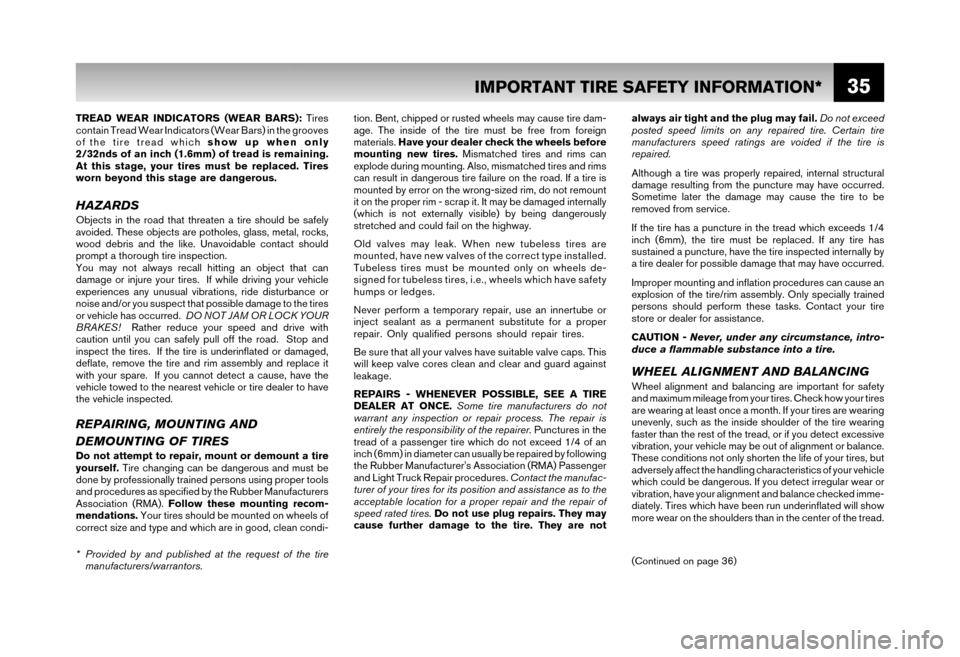tow bar NISSAN XTERRA 2006 N50 / 2.G Warranty Booklet
[x] Cancel search | Manufacturer: NISSAN, Model Year: 2006, Model line: XTERRA, Model: NISSAN XTERRA 2006 N50 / 2.GPages: 55, PDF Size: 1.67 MB
Page 40 of 55

35
TREAD WEAR INDICATORS (WEAR BARS): Tires
contain Tread Wear Indicators (Wear Bars) in the grooves
of the tire tread which show up when only
2/32nds of an inch (1.6mm) of tread is remaining.
At this stage, your tires must be replaced. Tires
worn beyond this stage are dangerous.
HAZARDSObjects in the road that threaten a tire should be safely
avoided. These objects are potholes, glass, metal, rocks,
wood debris and the like. Unavoidable contact should
prompt a thorough tire inspection.
You may not always recall hitting an object that can
damage or injure your tires. If while driving your vehicle
experiences any unusual vibrations, ride disturbance or
noise and/or you suspect that possible damage to the tires
or vehicle has occurred. DO NOT JAM OR LOCK YOUR
BRAKES! Rather reduce your speed and drive with
caution until you can safely pull off the road. Stop and
inspect the tires. If the tire is underinflated or damaged,
deflate, remove the tire and rim assembly and replace it
with your spare. If you cannot detect a cause, have the
vehicle towed to the nearest vehicle or tire dealer to have
the vehicle inspected.
REPAIRING, MOUNTING AND
DEMOUNTING OF TIRES
Do not attempt to repair, mount or demount a tire
yourself. Tire changing can be dangerous and must be
done by professionally trained persons using proper tools
and procedures as specified by the Rubber Manufacturers
Association (RMA). Follow these mounting recom-
mendations. Your tires should be mounted on wheels of
correct size and type and which are in good, clean condi- tion. Bent, chipped or rusted wheels may cause tire dam-
age. The inside of the tire must be free from foreign
materials.
Have your dealer check the wheels before
mounting new tires. Mismatched tires and rims can
explode during mounting. Also, mismatched tires and rims
can result in dangerous tire failure on the road. If a tire is
mounted by error on the wrong-sized rim, do not remount
it on the proper rim - scrap it. It may be damaged internally
(which is not externally visible) by being dangerously
stretched and could fail on the highway.
Old valves may leak. When new tubeless tires are
mounted, have new valves of the correct type installed.
Tubeless tires must be mounted only on wheels de-
signed for tubeless tires, i.e., wheels which have safety
humps or ledges.
Never perform a temporary repair, use an innertube or
inject sealant as a permanent substitute for a proper
repair. Only qualified persons should repair tires.
Be sure that all your valves have suitable valve caps. This
will keep valve cores clean and clear and guard against
leakage.
REPAIRS - WHENEVER POSSIBLE, SEE A TIRE
DEALER AT ONCE. Some tire manufacturers do not
warrant any inspection or repair process. The repair is
entirely the responsibility of the repairer. Punctures in the
tread of a passenger tire which do not exceed 1/4 of an
inch (6mm) in diameter can usually be repaired by following
the Rubber Manufacturer's Association (RMA) Passenger
and Light Truck Repair procedures. Contact the manufac-
turer of your tires for its position and assistance as to the
acceptable location for a proper repair and the repair of
speed rated tires. Do not use plug repairs. They may
cause further damage to the tire. They are not always air tight and the plug may fail.
Do not exceed
posted speed limits on any repaired tire. Certain tire
manufacturers speed ratings are voided if the tire is
repaired.
Although a tire was properly repaired, internal structural
damage resulting from the puncture may have occurred.
Sometime later the damage may cause the tire to be
removed from service.
If the tire has a puncture in the tread which exceeds 1/4
inch (6mm), the tire must be replaced. If any tire has
sustained a puncture, have the tire inspected internally by
a tire dealer for possible damage that may have occurred.
Improper mounting and inflation procedures can cause an
explosion of the tire/rim assembly. Only specially trained
persons should perform these tasks. Contact your tire
store or dealer for assistance.
CAUTION - Never, under any circumstance, intro-
duce a flammable substance into a tire.
WHEEL ALIGNMENT AND BALANCINGWheel alignment and balancing are important for safety
and maximum mileage from your tires. Check how your tires
are wearing at least once a month. If your tires are wearing
unevenly, such as the inside shoulder of the tire wearing
faster than the rest of the tread, or if you detect excessive
vibration, your vehicle may be out of alignment or balance.
These conditions not only shorten the life of your tires, but
adversely affect the handling characteristics of your vehicle
which could be dangerous. If you detect irregular wear or
vibration, have your alignment and balance checked imme-
diately. Tires which have been run underinflated will show
more wear on the shoulders than in the center of the tread.
* Provided by and published at the request of the tire manufacturers/warrantors.
IMPORTANT TIRE SAFETY INFORMATION*
(Continued on page 36)